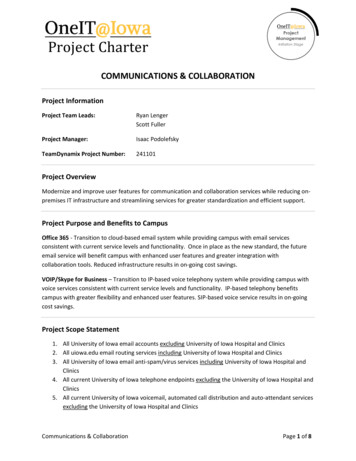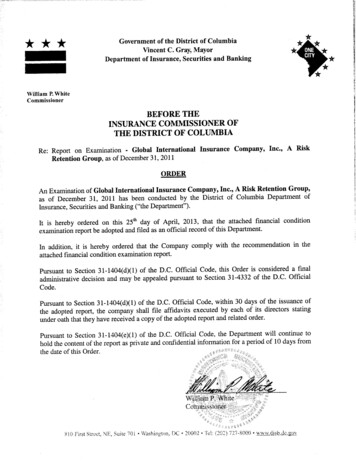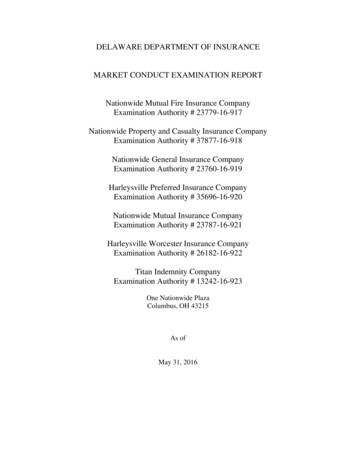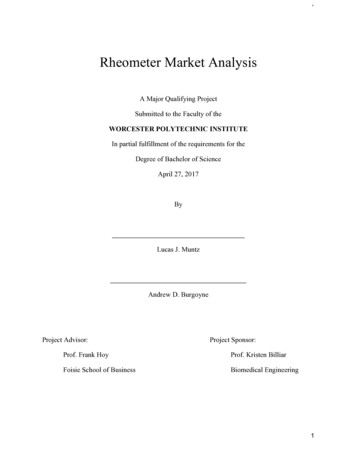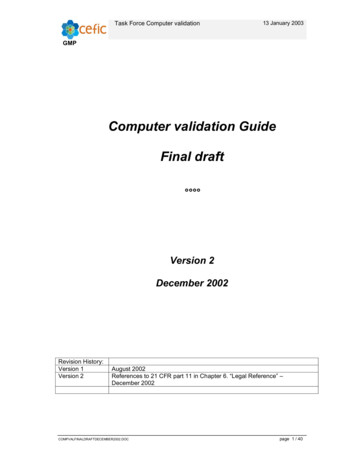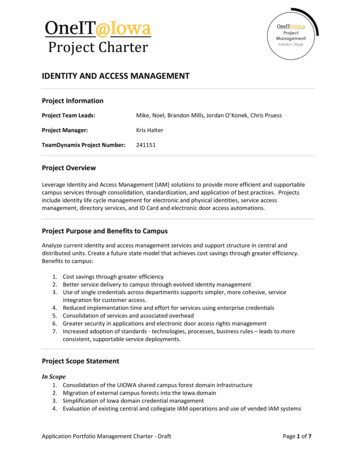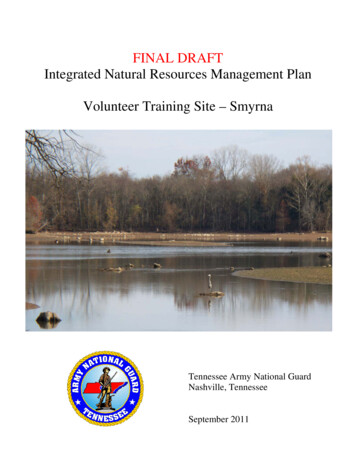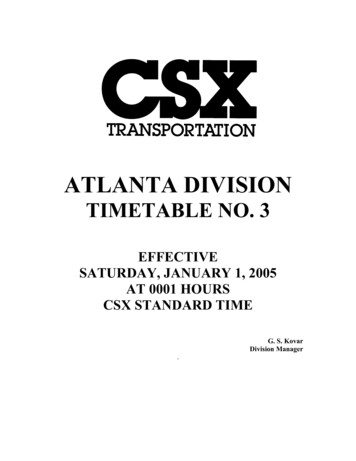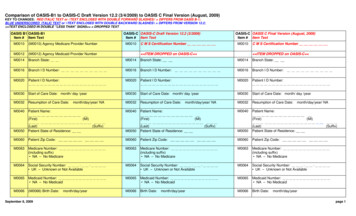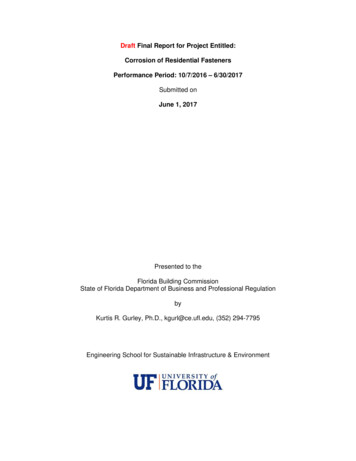
Transcription
Draft Final Report for Project Entitled:Corrosion of Residential FastenersPerformance Period: 10/7/2016 – 6/30/2017Submitted onJune 1, 2017Presented to theFlorida Building CommissionState of Florida Department of Business and Professional RegulationbyKurtis R. Gurley, Ph.D., kgurl@ce.ufl.edu, (352) 294-7795Engineering School for Sustainable Infrastructure & Environment
Table of Contentsof Contents1. Disclaimer . 12. Issues Being Addressed . 13. Applicable Sections of the Code and Related Documents . 14. Review of 2015 – 2016 Testing . 15. Statement of Work for 2016 - 2017 . 25.1. Work completed in this performance period . 36. Project Description of 2016 – 2017 testing . 36.1. Test protocol (TAS 114 Appendix E) . 36.2. Procurement of specimens tested . 36.3. Test-1 description and conditioning (150 samples) . 36.4. Test-2 description and conditioning (160 samples) . 46.5. Corrosion scale – performance metric. 57. Results of Corrosion Scoring . 67.1. Test-1 results . 67.1.1. Test-1 discussion . 87.2. Test-2 results . 97.2.1. Test-2 discussion .118. Comparison of Hot Dipped and Electrogalvanized Nail Corrosion Resistance.119. Conclusions .1210. Appendix A: Test-1 Corrosion results (photos for sample of each specimen type) .1311. Appendix B: Test-2 Corrosion results (photos for sample of each specimen type) .21
1. DisclaimerThis report presents the findings of research performed by the University of Florida. Anyopinions, findings, and conclusions or recommendations expressed in this report are those ofthe authors and do not necessarily reflect the views of the sponsors, partners and contributors.The appropriate Technical Advisory Committees of the Florida Building Commission will providea final disposition on the implications for the Florida Building Code.2. Issues Being Addressed Anecdotal information indicates that corrosion of fasteners has been observed across arange of installationsThe problem is more serious in coastal environments due to presence of chloride ionsIncreased manufacturing of these products outside the United State may be contributingto the problemThe 2015-2016 corrosion study focused ono Electrogalvanized roofing fasteners conforming to ASTM A641 or TAS 114Appendix E standardso Hot dipped fastenerso Roof tile fastenerso Screen enclosure fastenersThe 2016-2016 corrosion study identified performance issues that warrant further testing3. Applicable Sections of the Code and Related Documents 1622.1.2, Florida Building Code—Building1506.4 – 1506.7, Florida Building Code—Building1517.5.1 – 1517.5.2, Florida Building Code—BuildingGuide to Aluminum Construction in High Wind AreasTAS 114 Appendix EASTM A90ASTM A641ASTM A153ASTM B117-11ASTM G85-114. Review of 2015 – 2016 TestingThe 2015 – 2016 experimental study (phase 3) continued the testing roof system fasteners in acorrosion chamber, applying the TAS 114 Appendix E protocol and applying the customizedcorrosion scoring scale created for phase 2. In phase 3, the emphasis was on testing fastenersthat are ASTM A641 compliant (prescriptive) or Miami Dade County approved (performancebased TAS 114 Appendix E). Electrogalvanized, electroplated, mechanically galvanized, hotdipped, and stainless steel fasteners were included in the test matrix. Roofing, deck/patio,screen enclosure, and tile screw fasteners were also included. The following summary offindings was reported in the Final Report issued on June 21, 2016:1
It is assumed that Miami-Dade approved EG fasteners had been certified as TAS 114Appendix E compliant. However, the results did not reveal a single EG sample thatpassed that standard’s criterion of 5% surface corrosion. Each of the 30 such fastenersamples tested had a score of at least 3 (partial light surface corrosion) on both the headand shaft, and most samples displayed significant heavy corrosion. Each of the three EGspecimen types marked as Miami-Dade approved only referenced ASTM A641, not TAS114 Appendix E.The hot dipped, mechanically galvanized and stainless steel ceramic coated specimensdemonstrated little or no corrosion.The corrosion resistance of hot dipped specimens does not appear to be influenced(damaged) by installation. However, due to a relatively small sample size and theinclusion of only two specimen types, this conclusion is indicative rather than definitive.Testing on ceramic coated stainless steel screen enclosure fasteners revealed somedegradation to the ceramic coating on the stainless steel specimens. The exposedstainless steel did not exhibit significant corrosion. However, unlike metal reactions dueto loss of the coating barrier were not evaluated since these specimens were tested outof the box and not in an installed configuration.5. Statement of Work for 2016 - 2017The current 2016 – 2017 experimental study (phase 4) continues the testing of residentialfasteners in a corrosion chamber, applying the TAS 114 Appendix E protocol and applying thecustomized corrosion scoring scale created for phase 2. The testing plan is described asfollows: The 2015 - 2016 study revealed that the ceramic coating on stainless steel masonryscrews (commonly used for screen enclosures) peeled during the corrosion testing. Thismay create issues with unlike metal reactions when these fasteners are used inaluminum enclosures. The testing will install ceramic coated SS screws in aluminumprior to corrosion testing in order to investigate the implications of loss of coating withrespect to corrosion at the unlike metal interface.Additional tile fastener testing will be conducted to add multiple commonly used productsto the limited results from the 2015-2016 study.Hot dipped roofing fasteners performed much better than electrogalvanized fasteners inthe 2015-2016 study. Fasteners conforming to the ASTM A153 hot dipped standard andthe ASTM A641 minimum coating standard will be tested for relative performance.HVAC and metal panel clips and fasteners will be included in the 2016-2017 test matrixThe test protocol includes the following: Apply TAS 114 Appendix E testing (Section 2.6.1) to evaluate the degree of corrosionresistanceTesting will be conducted on both new and installed fasteners to determine the influenceof installation on corrosion resistanceTesting will include multiple samples of each specimen configuration2
5.1. Work completed in this performance periodThe performance period was sufficient to complete the majority, but not all of the fastenertypes listed in the statement of work. Testing was completed on Ceramic coated stainless steel masonry screws Roof tile screws Hot dipped nailsHVAC and metal panel clips and fasteners were not included in the test matrix due to timerestrictions attributable to: a) the use of 500 cycle (1000 hour) sequences for all completedtesting, b) factory required maintenance and upgrades to the test apparatus delayedtransitioning between test sequences.This report presents the results of testing completed on 310 specimens. 150 were testedsimultaneously in test-1, 160 were tested simultaneously in test-2. The results and analysisof test-1 were documented in the interim report issued on February 15, 2017, and will berepeated herein as well for completeness of this document. The results and analysis of test2 are documented herein for the first time.6. Project Description of 2016 – 2017 testing6.1. Test protocol (TAS 114 Appendix E)The test protocol followed TAS 114 Appendix E, which calls for compliance with ASTM G85Annex A5. The corrosion testing apparatus was factory programmed to follow the ASTM G85Annex A5 protocol. The acetic acid-salt spray (fog) test was conducted for 500 cycles (test-1and test-2), where one cycle consists of one hour of fog exposure and one hour of dry-off. Eachsequence was run without interruption over a 42 day period. The salt solution composition,chamber temperature, and water purity were monitored to conform to requirements. There is noconversion of this protocol to an equivalent time of in-field exposure to real conditions.6.2. Procurement of specimens testedAll test samples were procured off the shelf from Florida suppliers.6.3. Test-1 description and conditioning (150 samples)Test-1 includes 10 samples from each of 15 groups. These 15 groups include sheet metal andmasonry screws commonly used for screen enclosures, as well as roofing tile screws. Table 1summarizes the specimens in test-1. Groups 1 – 10 are masonry, SDS and SMS ceramiccoated stainless steel screen enclosure fasteners. Groups 11 – 13 are mechanically galvanizedand electroplated tile screws. Groups 14 and 15 are nylon capped ceramic coated casehardened steel masonry and SDS fasteners. Each of the 15 groups included 10 samples. Allsamples were tested for 1000 hours (500 cycles).3
Table 1: test-1: 15 specimen types, 10 samples each5 samples out-of-the-box, 5 samples installed in substrateStatus: completed 1000 hours (500 cycles)Product typeUseCertificationCoatingHex 3/8 x 5 304 Stainless whiteMasonryCeramic2Hex 3/8 x 7 304 Stainless whiteMasonry3Hex 1/4 x 3 ¼ 304 Stainless silverMasonry4Hex 1/4 x 2 ¼ 304 Stainless silverMasonry5Hex 1/4 10 x 2 SMS 316 Stainless bronze6Hex 1/4 12 x ¾ SDS 316 Stainless white7Hex 5/16 14 x 1 SDS 316 Stainless bronze8Hex 3/8 14 x 1 SDS 316 Stainless bronze9Hex 5/16 12 x 2 SDS 316 Stainless bronze10Hex 1/4 10 x 2 SDS Stainless white11#8 2 ½ mechanically galvanizedASTM B695 Class 55 2006 IRC Compliant#8 2 ½ tile screw heavy zinc electroplated#8 2 ½ mechanically galvanizedASTM B695 Class 55 2006 IRC CompliantHex 1/4 x 3 ¼ case hardened carbon steel blueNylon cap applied post-installHex 5/16 12 x 1 SDS case hardened carbon steelred, Nylon creenenclosureScreenenclosureScreenenclosureTile ovedMDCApprovedIRCTile screwTile icMGThe purpose of test-1 was to provide comparative corrosion performance of samples tested outof-the-box against samples installed into appropriate substrate prior to testing.Five samples from each of Groups 1 – 10, 14 and 15 were installed into aluminum screenenclosure stock prior to testing. The remaining five samples from each of Groups 1 – 10, 14 and15 were tested out-of-the-box.Five samples from each of Groups 11 – 13 were installed into roofing tiles and removed prior totesting. The remaining five samples from each of Groups 11 – 13 were tested out-of-the-box.6.4. Test-2 description and conditioning (160 samples)Test-2 includes 20 samples from each of 8 groups of hot dipped galvanized nails. Differentgroupings separate manufacturers and/or suppliers. Smooth and ring shank samples areincluded, as well as coil and hand-driven samples. Table 2 summarizes the specimens in test-2.4
Groupnumber1234Table 2: test-2: 8 hot dipped specimen types, 20 samples each10 samples out-of-the-box, 10 samples installed in substrateStatus: completed 1000 hours (500 cycles)Product typeCertification1-1/4” ring shank, coil gun1-1/4” ring shank, coil gun1-1/4” ring shank, coil gun1-1/4” smooth shank, coil gun56*1-1/4” ring shank, hand driven1-3/4” ring shank, hand driven71-1/4” ring shank, hand drivenASTM F1667 (ASTM A641)ASTM F1667 (ASTM A641)ASTM F1667 (ASTM A641)ASTM F1667ASTM A153 Class DUnknownASTM F1667ASTM A153 Class DASTM F1667ASTM A153 Class DUnknown81-1/4” ring shank, coil gunManufactured in China unless ** Manufactured in TaiwanThe purpose of test-2 was to provide comparative corrosion performance of samples tested outof-the-box against samples installed into appropriate substrate prior to testing. For each of the 8groups, 10 samples were tested out of the box, and 10 samples were driven into wood andremoved prior to testing.The second purpose of test-2 was to compare hot dipped performance for fasteners conformingto the ASTM A153 hot dipped standard and the ASTM A641 minimum coating standard. Thecertification provided on the box is provided in Table 2. As per language in ASTM F1667, it isassumed groups marked ASTM F1667 alone indicates compliance with ASTM A641 coatingthickness (Class 1).6.5. Corrosion scale – performance metricThe TAS 114 Appendix E pass/fail criterion is greater than 5% surface corrosion indicatesfailure. However, the purpose of this study is to investigate the relative performance of fasteners.This requires a finer gradation of performance than pass/fail can provide. An integer scale of 1 –8 was created to classify the degree of corrosion observed on the fasteners, where 1 indicatesno corrosion and 8 indicates heavy corrosion with scaling. Table 3 provides a description ofthese classifications as well as a visual sample of each. The assignment of a corrosion score foreach fastener is subjective to some degree, but the scale is designed such that this subjectivitydoes not span more than two adjacent scores. For example, 7 vs. 8 may be subjective, but 6 vs8 provides a clear distinction. In this manner, the subjectivity does not dilute the significance ofresults when viewed on an eight-point scale.5
Table 3: Corrosion scale description and sample images1: No corrosion observed2: Edge corrosion only3: Light partial surface corrosion4: Light full surface corrosion5: Partial heavy surface corrosion6: Partial heavy and partial light full surface corrosion7: Heavy full surface corrosion without scaling8: Heavy full surface corrosion with scaling7. Results of Corrosion ScoringThe 1-8 corrosion score was assigned to each tested specimen separately for the head andshaft of the fasteners. The scores were assigned based on visual inspection of the specimensas well as inspection of post-test photos taken of each specimen. Photos for one or twosamples of each group are provided in Appendix A and Appendix B.7.1. Test-1 resultsThe full scoring results (all ten samples from each of the 15 groups) are provided in Figures 1through 4. In each of these figures, the commonly colored bars correspond to the 10 individualsamples of that specimen type. Within any one color group of 10 bars, the left five are the6
installed samples, and the right five are the out-of-the-box samples. The bottom of the graphidentifies the specimen type by group number as defined in Table 1. The vertical axis presentsthe 1-8 corrosion scale score. The light blue bar spanning each commonly colored bar group isthe mean value of the 10 samples in that group. The results are stratified in figures 1 through 4as follows: Figure 1: Stainless steel ceramic coated masonry screwsFigure 2: Stainless steel ceramic coated self-driving and sheet metal screwsFigure 3: Tile screws, mechanically galvanized and electroplatedFigure 4: Case hardened carbon steel ceramic coated masonry and SDS screwsFigure 1: Test-1 Corrosion scale results for stainless steel ceramic coated masonry screws.Ten samples of each. Five out-of-the-box, five installed in aluminum.Per color grouping: left five are installed, right five are out-of-the-box.Figure 2: Test-1 Corrosion scale results for stainless steel ceramic coated self-driving and sheet metalscrews. Ten samples of each. Five out-of-the-box, five installed in aluminum.Per color grouping: left five are installed, right five are out-of-the-box.7
Figure 3: Test-1 Corrosion scale results for tile screws, mechanically galvanized and electroplated.Ten samples of each. Five out-of-the-box, five installed in tile and removed.Per color grouping: left five are installed, right five are out-of-the-box.Figure 4: Test-1 Corrosion scale results for case hardened carbon steel masonry and SDS screws, ceramiccoated. Ten samples of each. Five out-of-the-box, five installed in aluminum.Per color grouping: left five are installed, right five are out-of-the-box.7.1.1. Test-1 discussionFindings are summarized as follows: Figures 1 & 2: Consistent with the findings from the 2015 – 2016 study, the performanceof ceramic coated stainless steel masonry screws, SDS and SMS was excellent. Therewas no observed difference in corrosion resistance when comparing out-of-the-boxsamples with samples that were installed in aluminum. The loss of the ceramic coatingwas very common. Most samples had significant coating peeling after testing, and mostsamples that were installed in aluminum showed visible ceramic coating scratching priorto testing. However, this did not compromise the underlying stainless steel. The contactof unlike metals (stainless steel and aluminum) resulting from the loss of ceramic coatingdid not produce any observed corrosion. Figure 3: The performance of mechanically galvanized and electroplated roof tile screwswas consistent with the findings from the 2015 – 2016 study. In the previous study thetests were not run to the full duration of 500 cycles. The current test was run for the8
complete 500 cycles. Spots of light corrosion were observed on many samples, andothers showed no signs of corrosion. The samples installed into tile and removed prior totesting showed no difference in performance compared to the samples tested out-of-thebox. Electroplated samples showed slightly more corrosion than mechanicallygalvanized samples Figure 4: Ceramic coated case hardened carbon steel masonry screws and SDS exhibitsignificant corrosion on the shaft on most samples, and corrosion on the head on themasonry screws (the SDS had a nylon head). Installation in aluminum did not influencethe onset of corrosion on the shaft.7.2. Test-2 resultsScoring results (20 samples from the 8 groups) are provided in Figures 5 through 10. Thevertical axis presents the 1-8 corrosion scale score. The light blue bar spanning each commonlycolored bar group is the mean value of the 10 samples in that group. Figures 5 through 8present the all scoring results, one group per figure. Each figure presents nail head, nail shaft,installed and removed, and out of the box results. Figures 9 and 10 present the same data asFigures 5 through 8, but arranged to show all 8 groups in single figures for ease of comparison.Figure 5: Test-2 Corrosion scale results for Group 1 and Group 2. Twenty samples of each. Ten out-of-thebox, ten installed and removed from wood.Figure 6:
Jun 01, 2017 · The corrosion testing apparatus was factory programmed to follow the ASTM G85 Annex A5 protocol. The acetic acidsalt spray (fo- g) test was conducted for cycles (test500-1 and test-2), where one cycle consists
